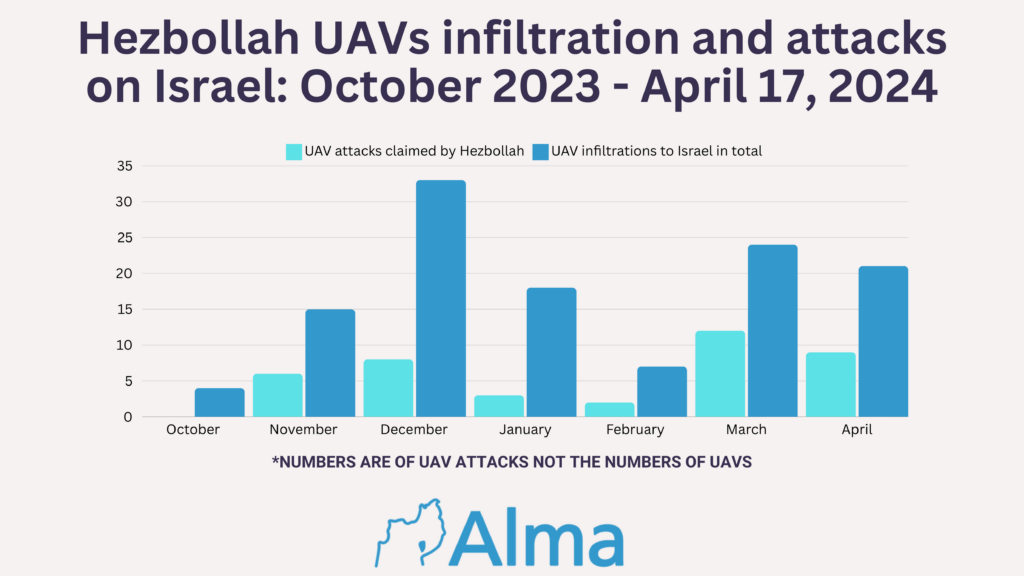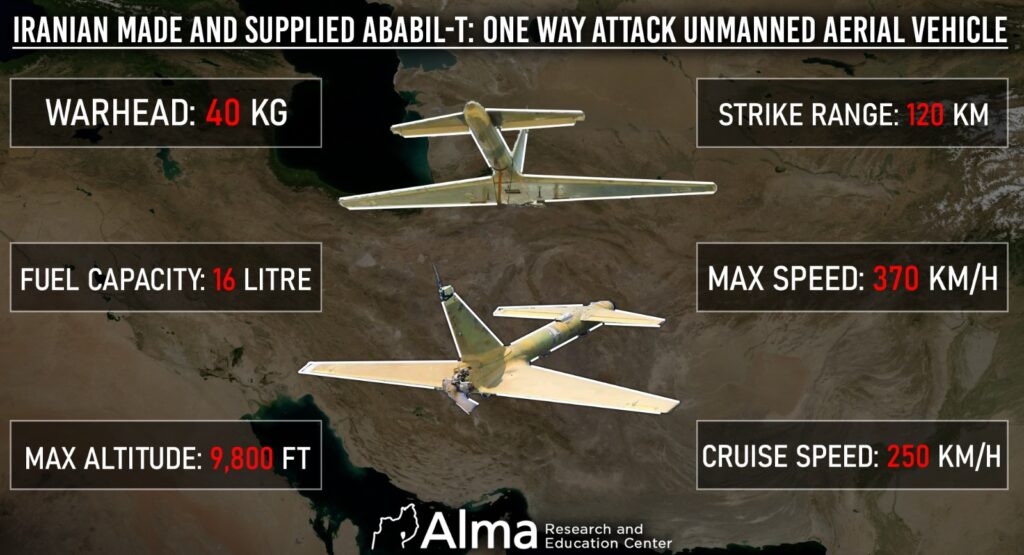On April 17, Hezbollah launched a coordinated attack on the community center in Arab al-Aramshe, in Western Galilee, deploying two Ababil T UAVs and anti-tank missiles, resulting in 18 deaths. In the last ten days, Hezbollah claimed responsibility for eight further suicide UAV assaults against Israel, injuring four more persons. The severity of these strikes is evident in their precision.
Hezbollah’s main suicide UAV is the Iranian Ababil-T, also known as the Mirsad-1. It is a UAV with a 120-kilometer assault range, a top speed of 370 kilometers per hour, the capacity to carry up to 40 kilograms of explosives, and the ability to fly at altitudes of up to 3,000 meters.

From the beginning of the war in the northern arena, Hezbollah began launching UAVs at Israeli territory. The numbers in the graph above indicate incident numbers rather than the number of UAVs in each incident. As of this writing, there have been at least 122 incidents of UAV infiltration, of which Hezbollah claimed responsibility for only 40 incidents in which it carried out attacks using suicide UAVs.
The main reason for the discrepancy in numbers is that Hezbollah refrains from claiming responsibility for launching a UAV when it is intercepted or when it falls and does not strike its target. For example, Hezbollah does not take responsibility for intelligence and photograph collecting UAVs. Hezbollah claims responsibility only for suicide UAVs that, in its opinion, succeed in striking their target.
Note the clear trend in the intensity of Hezbollah’s operation of the UAV system. The volume increased 3.5-fold in March 2024 compared to February 2024. 7 launch events in February compared to 24 in March. The trend becomes even sharper during April 2024. By April 17 (only half of the month), we had already witnessed 21 launching incidents (9 of which Hezbollah took responsibility). The number of UAV launch incidents so far in April is almost the same as the total number of incidents in all of March.
Hezbollah is expanding and enhancing its capacity to launch suicide UAV assaults. In many suicide UAV assaults, Hezbollah launches a combined attack with rocket, mortar, or anti-tank missile fire, ostensibly to create a distraction and occupy numerous defensive systems. Since the beginning of the war, Hezbollah has been regularly probing Israel’s northern border defenses. It often releases UAVs used as a decoy. This allows it to test and examine Israel’s warning, air defense, and electronic warfare systems. The decoy UAVs are launched at certain routes and altitudes to test the response, providing Hezbollah with operational data for the future and allowing it to prepare further suicide UAV assaults.
To date, the majority of Hezbollah’s suicide UAV assaults have targeted military sites close to the border, including Israeli military bases and Iron Dome batteries. However, there were other occurrences of UAV assaults in civilian regions in the following communities: Hazor HaGalilit, Kiryat Shmona, Maayan Baruch, Margaliot, and Hanita. Hezbollah claims that the objective of these assaults was military (mainly army troops). Since the start of the war, Hezbollah suicide UAV attacks have killed one person and injured 26 others.
Hezbollah has used UAVs since the 1990s. Hezbollah possesses a significant arsenal of Iranian-made and self-made UAVs. Hezbollah uses a variety of UAVs, including assault (launching missiles or dropping bombs), suicide, or intelligence gathering. During this conflict, Hezbollah used suicide UAVs against Israel for the first time. In addition to UAVs, Hezbollah operates a variety of drones (the majority of which are civilian drones adapted by Hezbollah for military purposes, including intelligence gathering, suicide drones, and drones that launch explosives and missiles).
Based on the photos and videos Hezbollah released after the attack on Arab al-Aramshe on April 17 (assuming they are reliable), it is possible that it collected preliminary intelligence by means of a UAV or a photographing drone.
In conclusion, UAVs have become a lethal and effective tool for Hezbollah, particularly given the reduced use of anti-tank missile fire. The UAVs allow Hezbollah operatives to carry out their activities at a distance from the border, while still precisely hitting military objectives. As a result, Hezbollah retains its precision strike capabilities even when it is not near the border and is not particularly vulnerable to IDF attacks.
Apparently, Hezbollah’s aerial unit appears to have sustained no major harm. This has to change, and a considerable operational effort must be directed at obstructing it.






